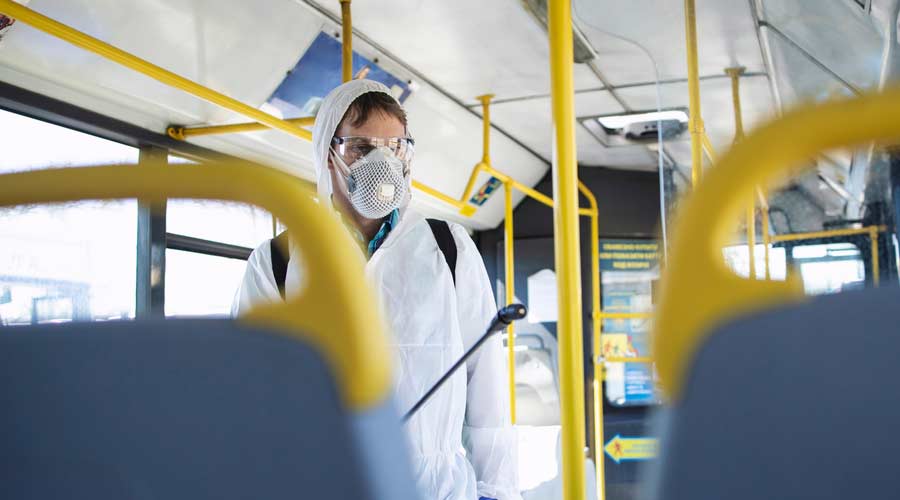
Electrostatic technology has long fascinated the cleaning community, and now this once-novel technology is gaining respect as a useful tool in infection control.
Made popular in the fight against COVID-19, electrostatic technology seems to have proven its worth as an effective means to rapidly disinfect large areas and hard-to-reach surfaces. Prior to the pandemic, electrostatic machines were already in use as an adjunct to routine cleaning services — an investment that has saved building service contractors (BSCs) time and labor and given facility managers piece of mind.
Post-pandemic, cleaning contractors like Steve Garcia are seeing fewer requests for blanket disinfecting, as well as more commercial offices requesting electrostatic spraying, with medical, educational and industrial facilities still actively pursuing services.
“The requests are more targeted than during the pandemic,” notes Garcia, Southwest regional vice president of SMI Facility Services, Albuquerque, New Mexico. “We now get requests to service individual offices and areas instead of entire facilities.”
While some facility clients continue to incorporate electrostatic spraying into their routine cleaning contracts, others call on BSCs only in emergency situations or request electrostatic services as a preventative measure in response to spikes in absenteeism. Although an increasing number of customers have worked disinfection services into their budgets, many still hesitate to take on the added expense of electrostatic spraying.
This is a mistake, says Tricia Holderman, president of Elite Facility Systems, Dallas. She advises clients to maintain proper disinfection by tapping into other budgets when feasible, such as wellness programs or risk mitigation funds. She also focuses on communicating efficiency and productivity gains that will ultimately benefit the customer.
“We need to help people understand that while the pandemic stage of things is over, this kind of disinfection is still very effective — and even more so in the non-healthcare sector,” says Holderman. “The reason being most of these clients have fallen off the wagon as far as the detailed cleaning they were doing. So, disinfecting with electrostatic equipment is an effective way to enhance disinfection of areas that they’re not getting to every day.”
Regaining Trust
Unfortunately, many reputable BSCs are still feeling the sting of fly-by-night companies that took advantage of the pandemic to offer questionable electrostatic services. Consequently, BSCs may need to regain facilities’ trust in electrostatic technology when promoting its benefits.
“It’s difficult to earn the client’s trust when you’re working with an invisible enemy,” notes Joel Craddock, president of Doc’s Facilities Solutions, Rochester, New York. “You have to be transparent with your customer and offer a proper explanation of your services.”
This includes educating customers about how the technology works. Simply stated, electrostatic machines impart a positive electrical charge to the chemical droplets as they exit the sprayer. These droplets then seek out and adhere to the negatively charged surfaces they are aimed at, enveloping objects to create a wraparound effect.
Understanding this process can help customers appreciate electrostatic equipment’s unique ability to target and disinfect difficult-to-reach areas quickly and easily.
Holderman recounts how electrostatic technology enabled Elite Facility Systems to reduce the number of staff hours spent manually wiping down equipment for the Washington Commanders football team.
“When we first started servicing the account, we spent 24 staff hours wiping down every ball, every bench, every weight and every physical therapy stretch band —every single night,” she recalls. “It was incredibly time-consuming. Once we started using the [electrostatic sprayer] we cut our labor hours down to eight, and the machine virtually paid for itself overnight.”
For customers who are on the fence, success stories like this lend credibility to electrostatic technology— not to mention the contract cleaning company providing the services. Additionally, Holderman often speaks at parent-teacher events and rotary clubs on the topic of electrostatic technology, piquing the interest of members who then share what they have learned with their schools and businesses.
No doubt one of the best ways to promote the use of electrostatic equipment is to offer proof that it works as promised. After providing electrostatic services, Craddock conducts walkthroughs of clients’ buildings to select areas for testing using an adenosine triphosphate (ATP) meter.
“It allows for transparency and takes a lot of the guesswork out,” he says. “Rather than doing random tests, we let the client choose areas to sample. They may know, for instance, that this person touches a lot of things and never covers their mouth when they cough or sneeze. Or they may want us to test specific areas, such as high-traffic areas or restrooms.”
Craddock will also recommend high-touch surfaces for testing to demonstrate the electrostatic technology’s wraparound effect.
“The electrostatic spray covers objects 360 degrees,” he notes. “You can test the back or underside of an object — such as a chair or push bar — and show your client that even though you only sprayed the front or top, you’ve taken care of out-of-the-way areas, too.”
While swab tests can give clients peace of mind that electrostatic equipment works as advertised — and confirm that BSCs are using it correctly — quantifying the technology’s long-term benefits is more challenging. Nevertheless, Craddock believes that over time, facilities should see their absenteeism rates decline and productivity rates increase as a result of electrostatic applications — a significant selling point for BSCs.
“Over the long haul, buildings will be cleaner and safer,” he says. “If people are healthier, they’re going to be happier — and they’re going to work harder. The end user should see an increase in productivity that offsets the cost.”
Training Tips for Electrostatic Spraying

 Celebrating BSCAI's 60th Anniversary eBook
Celebrating BSCAI's 60th Anniversary eBook The Down and Dirty on Cleaning in Virus Season
The Down and Dirty on Cleaning in Virus Season How Surfactant Use is Expanding in Commercial Cleaning
How Surfactant Use is Expanding in Commercial Cleaning